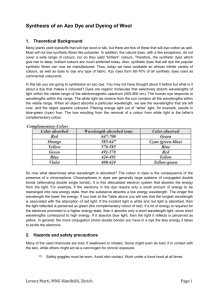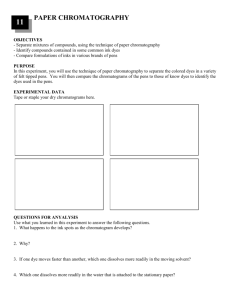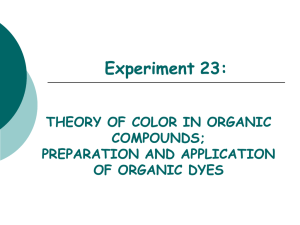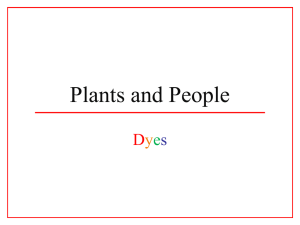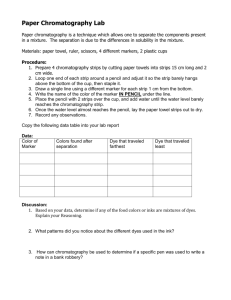Raw Data: Refer to Laboratory Syllabus for guidelines.
advertisement
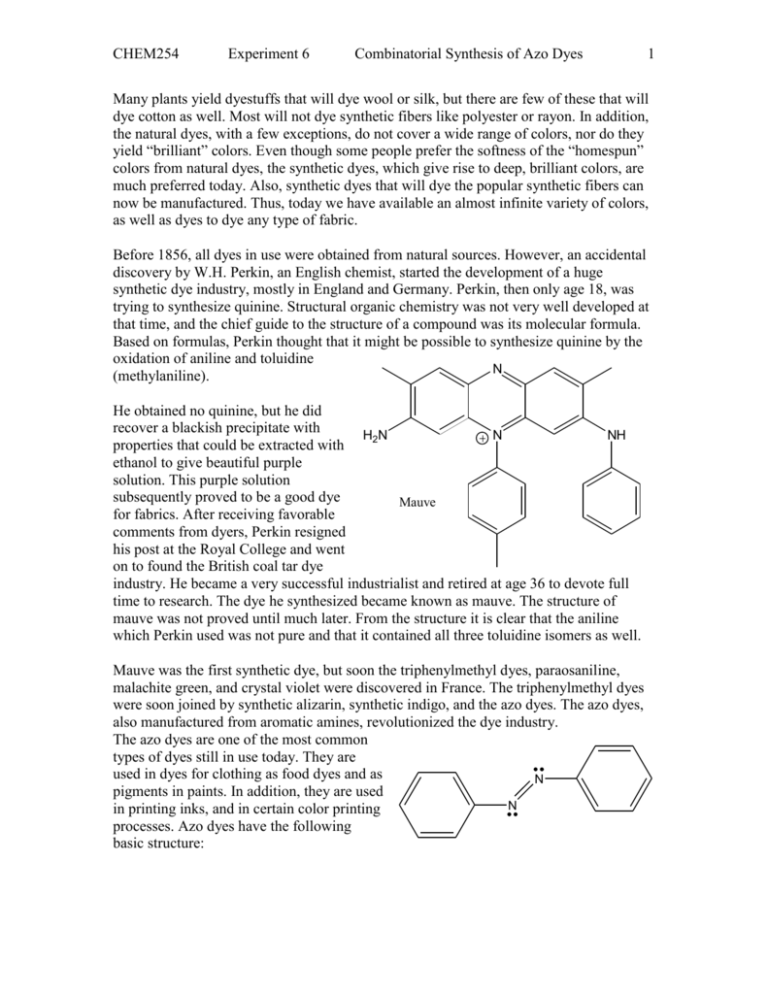
CHEM254 Experiment 6 Combinatorial Synthesis of Azo Dyes 1 Many plants yield dyestuffs that will dye wool or silk, but there are few of these that will dye cotton as well. Most will not dye synthetic fibers like polyester or rayon. In addition, the natural dyes, with a few exceptions, do not cover a wide range of colors, nor do they yield “brilliant” colors. Even though some people prefer the softness of the “homespun” colors from natural dyes, the synthetic dyes, which give rise to deep, brilliant colors, are much preferred today. Also, synthetic dyes that will dye the popular synthetic fibers can now be manufactured. Thus, today we have available an almost infinite variety of colors, as well as dyes to dye any type of fabric. Before 1856, all dyes in use were obtained from natural sources. However, an accidental discovery by W.H. Perkin, an English chemist, started the development of a huge synthetic dye industry, mostly in England and Germany. Perkin, then only age 18, was trying to synthesize quinine. Structural organic chemistry was not very well developed at that time, and the chief guide to the structure of a compound was its molecular formula. Based on formulas, Perkin thought that it might be possible to synthesize quinine by the oxidation of aniline and toluidine N (methylaniline). He obtained no quinine, but he did recover a blackish precipitate with H2N N NH properties that could be extracted with ethanol to give beautiful purple solution. This purple solution subsequently proved to be a good dye Mauve for fabrics. After receiving favorable comments from dyers, Perkin resigned his post at the Royal College and went on to found the British coal tar dye industry. He became a very successful industrialist and retired at age 36 to devote full time to research. The dye he synthesized became known as mauve. The structure of mauve was not proved until much later. From the structure it is clear that the aniline which Perkin used was not pure and that it contained all three toluidine isomers as well. Mauve was the first synthetic dye, but soon the triphenylmethyl dyes, paraosaniline, malachite green, and crystal violet were discovered in France. The triphenylmethyl dyes were soon joined by synthetic alizarin, synthetic indigo, and the azo dyes. The azo dyes, also manufactured from aromatic amines, revolutionized the dye industry. The azo dyes are one of the most common types of dyes still in use today. They are used in dyes for clothing as food dyes and as N pigments in paints. In addition, they are used N in printing inks, and in certain color printing processes. Azo dyes have the following basic structure: CHEM254 Experiment 6 Combinatorial Synthesis of Azo Dyes 2 The group containing the nitrogen-nitrogen double bond is called an azo group. To produce an azo dye, an aromatic amine is treated with nitrous acid to give a diazonium ion intermediate. This process is called diazotization. Cl NH 2 N + NaNO2 + 2HCl N + 2H2O + NaCl The diazonium ion is an electron deficient (electrophilic) intermediate. An aromatic compound, suitably rich in electrons (nucleophilic) will add to it. The most common used nucleophilic species are aromatic amines and phenols. The addition of the amine or the phenol to the diazonium ion is called diazonium coupling reaction. N N N N N N +H Azo dyes are both the largest and most important group of synthetic dyes. In making the azo linkage, many combinations are possible. These combinations give rise to dyes with a broad range of colors, encompassing yellows, oranges, reds, browns, and blues. The azo dyes, the triphenylmethyl dyes, and mauve are all synthesized from the anilines and aromatic substances. All of these substances can be found in coal tar, a crude material that is obtained by distilling coal. Perkin’s discovery led to the formation of a multimillion dollar industry based on coal tar, a material that was once widely regarded as a foul smelling nuisance. Today, these same materials can be recovered from crude oil or from petroleum as by-products in the refining of gasoline. Although we no longer utilize coal tar, many of the dyes are still in extensive use. Azo compound are easily reduced at the nitrogen-nitrogen double bond by reducing agents such as sodium hydrosulfite (Na2S2O4). Arguably, the most notable development in synthetic organic chemistry in the last decade is probably the so called combinatorial chemistry. The goal of combinatorial chemistry is to prepare a large number of structurally diversified but related compounds efficiently. A new journal has emerged that is devoted entirely to combinatorial chemistry. The pharmaceutical industry has embraced this new development and invested millions of dollars into the area. The products from a combinatorial synthesis are usually called a library, which must be screened for a desired activity. This desired activity could range from anti-tumor or anti-HIV properties to effective catalytic properties. CHEM254 Experiment 6 Combinatorial Synthesis of Azo Dyes 3 In this experiment, the principle of combinatorial chemistry is shown through preparing azo dyes using the combinatorial approach. The coupling reactions involve an aromatic diazo compound and a nucleophilic, water-soluble aromatic compound as the coupling partners. The so-called "point of diversification" involves the structure variation on each reactant. Each aromatic ring can be diversified by substitution pattern. Each student is assigned a unique coupling reaction on the basis of his/her drawer number. The entire class will perform the same basic reaction, but will attain a variety of products. Assay and the identification of individual compound are a straightforward process for this parallel experiment. A fabric dying experiment follows the coupling experiment. The color of the dyed multi-fiber strip serves as the final assay for this experiment. At the end of this experiment, the colors of the dyed multifiber strips from the entire class should be compared. Any conclusions from the correlation of the product structures to the colored strips should be discussed in the lab report. The products are arranged on a grid with aminobenzenesulfonic acid going across and the nucleophlic benzene derivatives going down. Each square of the grid is a unique combination of two reactants. SO3H A SO3H SO3H H2N Sulfanilic acid NH 2 B Metanilic acid NH 2 C 2-aminobenzene sulfonic acid 1 OH A1 B1 C1 1-naphthol 2 OH A2 B2 C2 A3 B3 C3 2-naphthol 3 OH CO 2H Salicylic acid CHEM254 Experiment 6 Combinatorial Synthesis of Azo Dyes 4 Procedure: I. Diazonium Salt Preparation In a small erlenmeyer place 1 g of an aminobenzenesulfonic acid and 10 mL of 2.6 % aqueous sodium carbonate. Make a solution of 0.4 g of sodium nitrite in 1 mL of water. Combine the two solutions. Into a 100 mL beaker place 1 mL of concentrated HC1 and 6 g of ice. The solution from the small erlenmeyer is added dropwise with a disposable pipet to the beaker. The resulting mixture is placed in ice-water bath to induce precipitation of the diazonium salts. The suspension is used in the next step. II. Coupling reaction In a a small beaker place 5.2x10-3 mole of one aromatic coupling reagent (1- or 2-naphthol, salicylic acid) and add 4 mL of a 2.5 M aqueous solution of sodium hydroxide. Place the beaker flask in a ice-water bath. The suspension of the diazonium salts prepared in the first step is added portionwise to the beaker. The reaction mixture is stirred with a glass rod after each addition. The color of the solution should change during this period of reaction. Let the reaction proceed for about 10 min with occasional stirring. Then heat the suspension on a hot plate till the solid dissolves. Add 2 g of NaCl and continue heating to dissolve it. Cool the beaker to room temperature first. Then cool it in an ice-water bath. Use a Hirsch or Buchner funnel to vacuum filter the solid. Wash the solid with 4 mL of saturated NaCl solution and let it dry in the air. Weigh the azo dye product when it is fully dry. III. Dying a fiber strip Disposable gloves should be worn in this experiment. Dissolve 0.1 g of the azo dye prepared in the previous step in 40 mL of water in a 150-mL beaker. Put a multi-fiber strip in the solution of the azo dye and keep it immersed. Boil the solution for about 5 minutes. Remove the multi-fiber strip from the hot solution with a tweezers and rinse the multi-fiber strip in a large beaker of tap water. Pat dry the dyed multi-fiber strip with a paper towel and compare the color with your lab mates. IV. Qualitative Test Put about 1 mL of your dye from the dye bath in a test tube and add solid sodium hydrosulfite (Na2S2O4). Observe the results. V. Clean up: Hand in your synthetic dye in a properly labeled vial: Your name, experiment number, compound name and the date. Dispose of filtrate and dye bath in a container in the hood. CHEM254 Experiment 6 Combinatorial Synthesis of Azo Dyes 5 Checklist for completing the "Prelab" section: (refer to Laboratory Syllabus for complete directions) ____ Title and date ____ Purpose. ____ Physical constants. Create a table of physical constants and safety data for the chemical compounds referred to in the procedure: http://domin.dom.edu/faculty/jbfriesen/chem254lab.htm ___ Flowchart. Refer to "Procedure" Structures and equations. The following products will be synthesized according to lab drawer number and the table on page 3 of the handout. 1&10 A1; 2&11 A2; 3&12 A3; 4&13 B1; 5&14 B2; 6&15 B3; 7&16 C1; 8&17 C2; 9&18 C3 ___ Draw the structure of your diazo intermediate as a chloride salt. ___ Draw the structure of you azo dye. ___ Write the balanced equation for the synthesis with structural formulas: aminobenzenesulfonic acid + sodium nitrite + HCl + aromatic coupling reagent diazo dye + water + sodium chloride ___ Calculations. Calculate the number of moles in 1.0 g of sulfanilic acid. Calculate the number of moles in 0.4 g of sodium nitrite. Calculate the mass of 5.2x10-3 mole of your aromatic coupling reagent. Calculate the molecular weight of your dye. Calculate the theoretical yield of your dye. Calculate the atom economy of the overall reaction. ___ Safety Question: Why is it necessary to do toxicology and carcinogenic studies of new clothes dyes before they can be used on commercial fabrics? Experimental Observations and Data: Hand in a copy of your experimental observations and data before you leave lab. Experimental Observations: Refer to Laboratory Syllabus for guidelines. Raw Data: Refer to Laboratory Syllabus for guidelines. 'Cold hearted orb that rules the night, Removes the colours from our sight. Red is grey and yellow white, But we decide which is right. And which is an illusion? The Moody Blues, Days of Future Passed CHEM254 Experiment 6 Combinatorial Synthesis of Azo Dyes 6 Lab Report Checklist: Presentation of Data. ____ Calculate percent yield of your dye. Show calculations ____ Summarize the results of dyeing the multi-fabric swatch. Hand in dyed multi-fiber strip please. Interpretation of Data. _____ Draw the structure of your product. _____ How did the directing properties (ortho-para or meta) of your nucleophilic coupling partner influence the structure of your product? _____ What would be the result if cuprous chloride (CuCl) were added to the diazonium salt prepared in this reaction? Draw the structure. HO _____From what starting compounds would you synthesize “Para Red?” "para-red" N O2N N _____ Consider the overall appreciation of your synthetic dye. What are 2 good points as a dye (usefulness)? _____ Consider the overall appreciation of your synthetic dye. What are 2 bad points as a dye (limitations) _____ What dye colors did you observe for your dye and others? How do you account for the differences between the colors of the different dyes? _____ What is your favorite color? Why? Now Israel loved Joseph more than any of his other sons, because he had been born to him in his old age; and he made him a coat of many colors. Genesis 37:3 Experimental procedures are based on the lab manual: Daniel R. Palleros, Experimental Organic Chemistry, John Wiley & Sons, Inc., New York, 2000, pp. 627-628. A Combinatorial Experiment Suitable for Undergraduate Laboratories Benjamin W. Gung and Richard T. Taylor Journal of Chemical Education, Vol 81, No. 11, November 2004

